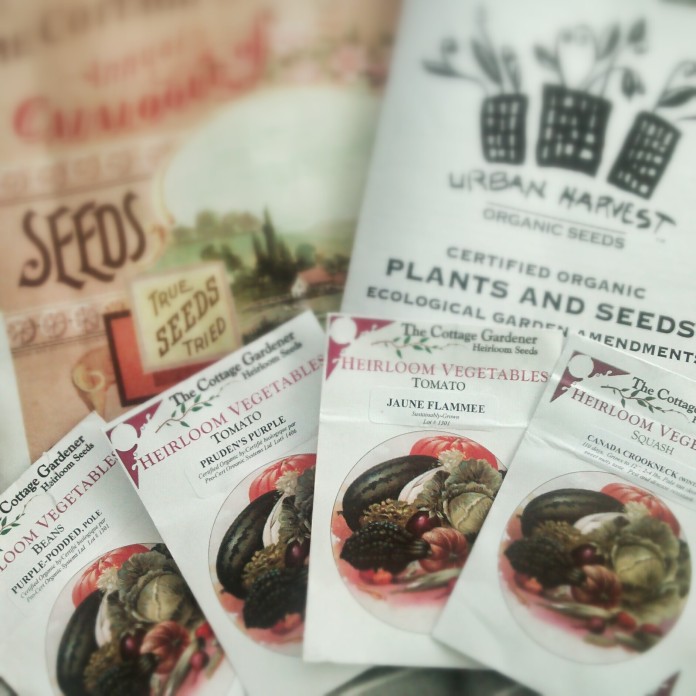What a highly stimulating, incredibly educational week focused on developing greater local resilience as we transition to a future filled with uncertainty. Covering such broad topics as creating integrated communities, inner transitions to be more effective at effecting outer changes, the relationship between seeds, people and a changing climate as well as many more I couldn’t make it to. It’s taken most of the week to sort through all the people I met and connected with; whether it was around common values or goals, past experiences or future plans, something that became clear was how little most people understand the needs of seedlings being grown indoors. Following this years theme of collaboration as well as bringing my focus back to more practical material needs, instead of the ephemeral inner space I’ve shifted to, this post will be focused on how to grow healthy, resilient seedlings…
With the odd subliminal reference to our need to transition our lives and communities, not that I’d try and be subversive or anything. Just remember, keep calm and garden on, nothing to see here…
So we’ll start in a more expansive, conceptual space and move towards specifics. Which is my general philosophy of gardening, start from the macro and work to the micro. The first and most important concept I want to get across is your role as a gardener in caring those wee seedlings you’ll be babying for the next month or two. A lot of people get tripped up by thinking of plants as mechanistic objects instead of unique living beings like ourselves. Often customers would ask when I managed the hydro shop “what product will fix X problem”, like a car, addressing the symptom without understanding the root cause. That rarely works as you end up chasing problems, instead of addressing the plants needs. If we shift our focus from mechanic to trainer, someone who’s creating the right space for the plant to do what we need, our little wards respond instead of comply. Put in another way, as a little hellion back in school, the more my teachers took an authoritarian stand, the more I rebelled out of principle. Those who took a more sagely, less direct approach by creating the space for me to realise my own ignorance tended to teach me more. I’ve had a long tradition of being my worst enemy, proof positive I’m not nearly as smart as my tendency for big words makes me appear…
Back to the point though, before I stray too far off topic, looking at the most important aspects of the climate we create for our plants-to-be we can break them down to four broad sections; light, air, water and earth. I purposefully use those terms to rely on the primal association with the elements, after all we’re trying to replicate the world around us as much as possible, only creating the ideal instead of what actually happening around us. For instance as I write this, there’s cold rain and possible flurries expected over the next couple days, which wouldn’t make happy seedlings. You do want happy seedlings right?
We’ll start with lighting, not because it’s the first one I put down but because in the interconnected web we’re weaving, lighting is one of the biggest factors that’ll shape all the rest. Those little photons bombarding the leaves is their fuel, their food and something that’s very misunderstood. First off, it’s not the heat generated by the light that determines how useful it is like most seem to think. With lighting our two biggest concerns are the intensity and spectrum. We need enough light in the right wave length to feed out plants and power everything else. Which is why shelves in front of a south facing window will usually work just as well as fluorescent lights, since the sun is much brighter and complete then any light bulb we’ve made to date. If we combine the two, supplementing natural light to extend the photoperiod (i.e. day length for normal, non plant-geeks) we get even better results. A couple key points to think of when considering your lighting include; getting them as close as possible and avoid marketing at all costs. Light intensity diminishes exponentially fast with indoor lights, called the inverse rule, it states that the square of the distance determines the drop in power. So at 2ft light has ¼ the power, at 3ft only 1/9th is reaching the plants. Which is why we keep our lights as close as possible without the heat generated by the bulb being an issue. For fluorescents that’s usually an inch or two, usually they won’t burn a leaf until it’s been touching the bulb for a bit but it’s always good to give them room to grow. That’s also why we want to keep our plants short, so that the top and bottom are getting equal light, otherwise the lower growth will stretch more trying to meet it’s needs and spend energy growing stem instead of bigger roots. The second key point, avoiding marketing, is my subtle way to get a jab in against one of my many pet peeves (which I’ve already ranted about previously and will again in the future, but not this time). Specifically I’m referring to the “plant and aquarium” tubes often sold alongside normal fluorescent tubes. The difference being a heavy phosphor coating on them to improve their spectrum, which sounds great, until you look at their intensity which is anywhere from a third to half as much because of that spiffy coating. All for an added cost and the feel good delusion that you’re treating your plants right. If we combine cool and warm bulbs we can get a similar spectrum with all those extra photons bouncing around, saving some money at the same time. So always look at both the intensity of a light as well as it’s spectrum before investing in your lights. With all that being said, fluorescents aren’t a great light source as they’re pretty weak overall, unfortunately not many people can justify more expensive H.I.D. or L.E.D. set ups so I won’t waste your time talking about them, as always though feel free to ask if you have any questions as I love an excuse to ramble on.
Next we move onto considering the air quality and dispel one of the biggest myths about growing plants indoors. That being that it’ll lead to mould and water damage, which is a possibility but not if you want happy seedlings. If you’ve read this far, you must want happy seedlings or have a masochistic tendency to read esoteric long winded blogs I suppose. Looking at air we’re worried about how hot, dry/wet and rich it is. First to state the obvious, plants don’t have lungs and can’t move, which means the air has to move around them, unlike us who move the air around ourselves. Without a fan disturbing the air, a leaf will use all the CO2 around it within a couple minutes in good conditions. Which starts to tie back to lighting (I did mention we’re weaving a web here right?) as that’ll determine how active the photosynthesis is, setting the rate that CO2 will be used to make sugar. There are ways to supplement CO2 but good air flow and proper ventilation also reduce bacterial and fungal pressure, so start there and leave the complex options for when your obsession blossoms into a full blown addiction. A simple oscillating fan (oscillating so the leaves don’t get wind burned) not only effectively keeps the air fresh, it also strengthens the stem as they wiggle and jiggle, causing the cells to toughen up just like working out our muscles. Puny humans can use their brains to survive, puny plants tend to be overtaken by weeds unfortunately. Otherwise I’d be all over nerdy gardens filled with plants in big square glasses and sporting the newest pocket protectors. The air also determines the temperature and humidity around our seedlings, both of which are effected by the light source. Luckily fluorescents tend to be pretty cool, so as long as the rooms comfortable they should be happy. Remember that humidity is a relative measure of how much water the air will hold at a given temperature, lower the temp and the humidity rises. We start growing indoors because the outdoors isn’t warm enough, for long enough, to get some crops to ripen. So it’s not that the temperature isn’t important, just that it’s not directly related to lighting indoors. Outdoors where the light and heat source are the same, that brilliant light bulb burning above us affectionately called the sun, it’s a different story. Indoors it’s better to control them separately which is why we’ve invented spiffy ways of cooling bulbs like air cooled hoods. We don’t need to worry about that though, with fluoro’s (that’s right, I’ve already gotten tired of typing out the whole word and have finally reverted to interweb speak) as long as the air is around 25°C and between 50-60% humidity, you’ll have an active metabolism. Which is also why we don’t have to worry about mould or fungus as in that range it won’t actively grow. A simple min-max hygro/thermometer is worth it’s weight in gold as it’ll let you know how much drift you’re getting over a 24 hour period. The more stable the climate, the happier the plants. Which is another helpful little tip for growing stronger plants indoors, the temperature differential between the day and night effects how much a plant stretches. As we want to have dense, compact plants keep them as close to even will keep the plants from stretching too much.
Which is where we’ll end it for today, there’s a lot to chew on there and I’m sure everyone has more important things to do then spending hours reading this post. I’ll finish with part II this weekend, covering; water, earth and getting down to some of the micro aspects of keeping plants alive and happy, so they in turn can keep you alive and healthy by providing lots of good food. Thanks for sticking it through and don’t hesitate to ask any questions if I haven’t been clear in my explanation or if you’d like more info on any particular aspect.

